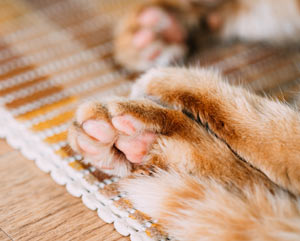How Do Cats Sweat?

Have you ever watched your cat on a hot day, when you were looking for a way to cool down, and wondered how cats sweat?
How Cats Sweat
Cats do have some sweat glands, but their skin is covered in fur, so this minimizes the amount of cooling the sweat can provide. The paw pads have the most sweat glands. You may see damp footprints from your cat walking on a hard surface in the summertime.
Cats also lick the fur over their bodies to distribute saliva that will evaporate to cool them down, much like sweat would do.
Cats "beat the heat" mostly by resting in the shade, spreading their body out on a cool surface, and not exerting themselves.
Panting is another way that cats can cool themselves down. It works by allowing heat from the hottest part of the body, the inner thorax, to escape through moisture produced by mucous membranes of the tongue, mouth, and throat. The cat exhales the moist air and the process of evaporation cools the cat. Although it is the most efficient way of cooling, panting is not a common occurrence in cats like it is in dogs. Only extremely heat-stressed cats will pant, so if your cat is panting, you need to be concerned that she is too hot. Help your cat to cool herself by wetting her fur with cool water, providing cool water to drink, and moving her to a cooler area. You can learn more here: "Heat Stroke and Hypothermia."
How Does a Cat's Body Temperature Stay Within the Normal Range?
Body temperature is controlled by the brain. When there are increases in outside temperatures or a cat is excited, stressed, or has been recently active, the body gets a signal from the brain to disperse the extra body heat. Sweating, stretching out the body, or drinking cool water are primary ways that cats cool down. If these processes cannot be performed or the body is overwhelmed and cannot cool itself enough, heat stroke and death may occur.
Fever or Just Hot?
A temperature consistently over 102.8˚ F is cause for concern in cats. Signs of fever include reluctance to move, increased frequency of breathing, depression, anorexia, and lethargy or listlessness.
Hyperthermia is simply an increase in body temperature. This may be due to increased outside temperatures, excitement, exercise, or other causes. It is not a true fever.
If you are unsure whether your cat actually has a fever, rest her for 20 minutes, then check the rectal temperature again. If your cat is acting normal other than panting and having an increased temperature, chances are it is hyperthermia and not a true fever.
Why Does My Cat Have an Increased Temperature?
What Increases Heat Stroke Risk?
- Heart or lung disease
- Any sickness; even a cold
- Being overweight
- Being young; kittens are at higher risk
- Being elderly
- Dehydration
As discussed above, body temperature may be increased due to many things. Fever increases the body's set temperature (range of temperature in which body systems can function normally) to assist the immune system by activating immune cells to attack the foreign invader, such as a bacterial infection. With increased environmental temperatures and other causes of hyperthermia, the body's set temperature is not increased. The body can cool itself over a short period of time and return to a normal temperature as long as cooling mechanisms are not overwhelmed by too much intense heat.
Emergency Measures
If your cat seems to be overheated or is not acting normal, contact your veterinarian immediately. Continued panting after cooling measures have been performed is not normal. Heat stroke is possible in cats, and can be lethal. Organ failure, brain swelling, blood clotting disorders, or death may occur with heat stroke. In a very hot cat, applying cool water to the groin, armpits and front of the neck will cool her. A fan may also be directed toward her to help cool her. Provide water to drink and contact your veterinarian. Your veterinarian may give IV fluids and hospitalize your cat for additional treatments and monitoring.
Common sense and thinking ahead will allow you to avoid serious complications from overheating in your cat. Remember, if you are hot, your cat is hot. Cats are not people—they have their own unique ways of staying cool.
Protect Your Cat from Heat Stroke:
- Have fresh water available at all times.
- Keep your cat indoors.
- If you take your cat outside, keep her in the shade.
- Never leave a cat in a car.
- Call your veterinarian if your cat acts sick or strange.
Works Cited
- William R. Fenner, Quick Reference to Veterinary Medicine (Baltimore: Lippincott Williams & Wilkins, 2000), 60.
- Michael R. Lappin, DVM, PhD Feline Internal Medicine Secrets (Philadelphia: Hanley & Belfus, Inc., 2001), 326.
You May Also Like These Articles:
Dehydration in Cats: How Can You Tell If A Cat Is Dehydrated?
Giving Your Cat Clean and Fresh Water
Pica in Cats: Why Cats Eat Strange Things
Notice: Ask-a-Vet is an affiliated service for those who wish to speak with a veterinary professional about their pet's specific condition. Initially, a bot will ask questions to determine the general nature of your concern. Then, you will be transferred to a human. There is a charge for the service if you choose to connect to a veterinarian. Ask-a-Vet is not manned by the staff or owners of CatHealth.com, and the advice given should not delay or replace a visit to your veterinarian.





